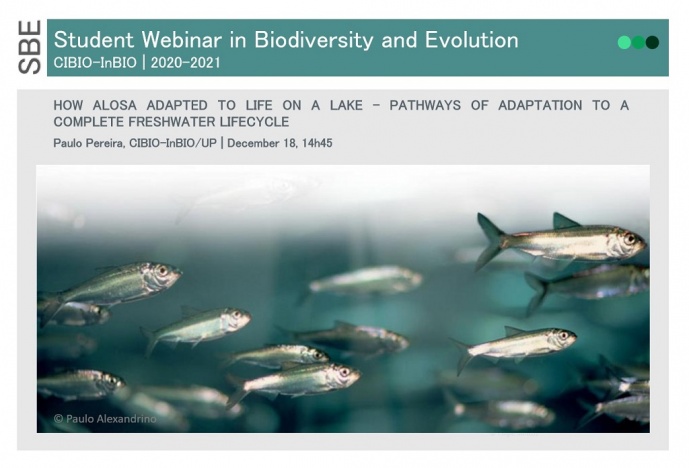How Alosa adapted to life on a lake - pathways of adaptation to a complete freshwater lifecycle
18 Dec 2020 - Paulo Pereira, CIBIO–InBIO/UP | 14h45

STUDENT WEBINAR IN BIODIVERSITY AND EVOLUTION
Understanding the mechanisms that allow species to rapidly adapt to different environments is important for forecasting how they will be impacted by continued global climate change. To investigate this topic, we studied anadromous populations of four Eurasian shad lineages that have independently adapted to a completely freshwater environment over two different time scales ranging from hundreds to thousands of generations. The freshwater populations of three of the lineages of Alosa here studied, inhabit lakes in Italy (Alosa fallax lacustris), Ireland (A. f. killarnensis) and Greece (A. macedonica) and were naturally landlocked likely sometime during the last 30 thousand years, at the end of the Pleistocene. As for the A. alosa lineage, freshwater populations were all artificially landlocked in reservoirs in Portugal during the last century. These different time scales for adaptation make the Eurasian shad an extraordinary system to study not only how species adapt to new conditions, but also if and how these strategies converge across lineages and time. In this presentation, we will explore which mechanisms were used by each lineage to adapt to the new conditions, evaluate the magnitude of parallel evolution across lineages, while taking into consideration potential constraints to its occurrence. To do so, whole genome data for 16 populations was used in combination with a de novo draft genome of A. alosa. Complementarily, we will also explore the role of epigenetic mechanisms in adaptation in the recently landlocked population of A. alosa of Castelo de Bode dam and its anadromous counterpart population from Tejo river. These two populations were screened for 5-methylcytosine - an inheritable methylated form of cytosine that is known to regulate gene expression – allowing the identification of differentially methylated regions, with potential implication in gene regulation. To conclude, we will draw comparisons between both data types and their potential implications for the species adaptation to freshwater.
Paulo Pereira holds a MSc in Biodiversity, Genetics and Evolution from the University of Porto. Currently, Paulo is a PhD student in his second year of the BIODIV program and working under the supervision of Dr. Miguel Carneiro (CIBIO-InBIO) and Dr. Stephen Sabatino (CIBIO-InBIO). Paulo's interests focus on understanding the role of regulatory changes in the adaptation to new environments through cutting-edge genomic tools and bioinformatic pipelines.
[Host: Stephen Sabatino, EVOLGEN, MARCHANGE]